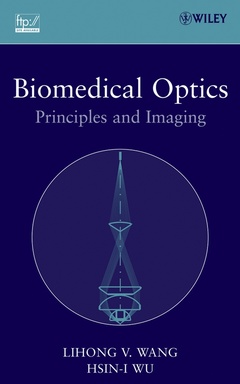Biomedical Optics Principles and Imaging
Auteurs : Wang Lihong V., Wu Hsin-i

A solutions manual is available for instructors; to obtain a copy please email the editorial department at ialine@wiley.com.
1. INTRODUCTION.
1.1.Motivation for optical imaging.
1.2.General behavior of light in biological tissue.
1.3.Basic physics of light-matter interaction.
1.4.Absorption and its biological origins.
1.5.Scattering and its biological origins.
1.6.Polarization and its biological origins.
1.7.Fluorescence and its biological origins.
1.8.Image characterization.
1.9.References.
1.10.Further readings.
1.11.Problems.
2. RAYLEIGH THEORY AND MIE THEORY FOR A SINGLE SCATTERER.
2.1.Introduction.
2.2.Summary of the Rayleigh theory.
2.3.Numerical example of the Rayleigh theory.
2.4.Summary of the Mie theory.
2.5.Numerical example of the Mie theory.
2.6.Appendix 2.A. Derivation of the Rayleigh theory.
2.7.Appendix 2.B. Derivation of the Mie theory.
2.8.References.
2.9.Further readings.
2.10.Problems.
3. MONTE CARLO MODELING OF PHOTON TRANSPORT IN BIOLOGICAL TISSUE.
3.1.Introduction.
3.2.Monte Carlo method.
3.3.Definition of problem.
3.4.Propagation of photons.
3.5.Physical quantities.
3.6.Computational examples.
3.7.Appendix 3.A. Summary of MCML.
3.8.Appendix 3.B. Probability density function.
3.9.References.
3.10.Further readings.
3.11.Problems.
4. CONVOLUTION FOR BROADBEAM RESPONSES.
4.1.Introduction.
4.2.General formulation of convolution.
4.3.Convolution over a Gaussian beam.
4.4.Convolution over a top-hat beam.
4.5.Numerical solution to convolution.
4.6.Computational examples.
4.7.Appendix 4.A. Summary of CONV.
4.8.References.
4.9.Further readings.
4.10.Problems.
5. RADIATIVE TRANSFER EQUATION AND DIFFUSION THEORY.
5.1.Introduction.
5.2.Definitions of physical quantities.
5.3.Derivation of the radiative transport equation.
5.4.Diffusion theory.
5.5.Boundary conditions.
5.6.Diffuse reflectance.
5.7.Photon propagation regimes.
5.8.References.
5.9.Further readings.
5.10.Problems.
6. HYBRID MODEL OF MONTE CARLO METHOD AND DIFFUSION THEORY.
6.1.Introduction.
6.2.Definition of problem.
6.3.Diffusion theory.
6.4.Hybrid model.
6.5.Numerical computation.
6.6.Computational examples.
6.7.References.
6.8.Further readings.
6.9.Problems.
7. SENSING OF OPTICAL PROPERTIES AND SPECTROSCOPY.
7.1.Introduction.
7.2.Collimated transmission method.
7.3.Spectrophotometry.
7.4.Oblique-incidence reflectometry.
7.5.White-light spectroscopy.
7.6.Time-resolved measurement.
7.7.Fluorescence spectroscopy.
7.8.Fluorescence modeling.
7.9.References.
7.10.Further readings.
7.11.Problems.
8. BALLISTIC IMAGING AND MICROSCOPY.
8.1.Introduction.
8.2.Characteristics of ballistic light.
8.3.Time-gated imaging.
8.4.Spatial-frequency filtered imaging.
8.5.Polarization-difference imaging.
8.6.Coherence-gated holographic imaging.
8.7.Optical heterodyne imaging.
8.8.Radon transformation and computed tomography.
8.9.Confocal microscopy.
8.10.Two-photon microscopy.
8.11.Appendix 8.A. Holography.
8.12.References.
8.13.Further readings.
8.14.Problems.
9. OPTICAL COHERENCE TOMOGRAPHY.
9.1.Introduction.
9.2.Michelson interferometry.
9.3.Coherence length and coherence time.
9.4.Time-domain OCT.
9.5.Fourier-domain rapid scanning optical delay line.
9.6.Fourier-domain OCT.
9.7.Doppler OCT.
9.8.Group velocity dispersion.
9.9.Monte Carlo modeling of OCT.
9.10.References.
9.11.Further readings.
9.12.Problems.
10. MUELLER OPTICAL COHERENCE TOMOGRAPHY.
10.1.Introduction.
10.2.Mueller calculus versus Jones calculus.
10.3.Polarization state.
10.4.Stokes vector.
10.5.Mueller matrix.
10.6.Mueller matrices for a rotator, a polarizer, and a retarder.
10.7.Measurement of Mueller matrix.
10.8.Jones vector.
10.9.Jones matrix.
10.10.Jones matrices for a rotator, a polarizer, and a retarder.
10.11.Eigenvectors and eigenvalues of Jones matrix.
10.12.Conversion from Jones calculus to Mueller calculus.
10.13.Degree of polarization in OCT.
10.14.Serial Mueller OCT.
10.15.Parallel Mueller OCT.
10.16.References.
10.17.Further readings.
10.18.Problems.
11. DIFFUSE OPTICAL TOMOGRAPHY.
11.1.Introduction.
11.2.Modes of diffuse optical tomography.
11.3.Time-domain system.
11.4.Direct-current system.
11.5.Frequency-domain system.
11.6.Frequency-domain theory: basics.
11.7.Frequency-domain theory: linear image reconstruction.
11.8.Frequency-domain theory: general image reconstruction.
11.9.Appendix 11.A. ART and SIRT.
11.10.References.
11.11.Further readings.
11.12.Problems.
12. PHOTOACOUSTIC TOMOGRAPHY.
12.1.Introduction.
12.2.Motivation for photoacoustic tomography.
12.3.Initial photoacoustic pressure.
12.4.General photoacoustic equation.
12.5.General forward solution.
12.6.Delta-pulse excitation of a slab.
12.7.Delta-pulse excitation of a sphere.
12.8.Finite-duration pulse excitation of a thin slab.
12.9.Finite-duration pulse excitation of a small sphere.
12.10.Dark-field confocal photoacoustic microscopy.
12.11.Synthetic aperture image reconstruction.
12.12.General image reconstruction.
12.13.Appendix 12.A. Derivation of acoustic wave equation.
12.14.Appendix 12.B. Green's function approach.
12.15.References.
12.16.Further readings.
12.17.Problems.
13. ULTRASOUND-MODULATED OPTICAL TOMOGRAPHY.
13.1.Introduction.
13.2.Mechanisms of ultrasonic modulation of coherent light.
13.3.Time-resolved frequency-swept UOT.
13.4.Frequency-swept UOT with parallel-speckle detection.
13.5.Ultrasonically modulated virtual optical source.
13.6.Reconstruction-based UOT.
13.7.UOT with Fabry-Perot interferometry.
Problems.
Reading.
Furhter Reading.
APPENDIX A. DEFINITIONS OF OPTICAL PROPERTIES.
APPENDIX B. List of Acronyms.
Index.
HSIN-I WU, PhD, is Professor of Biomedical Engineering at Texas A&M University. He has published more than fifty peer-reviewed journal articles. Dr. Wu was a senior Fulbright scholar and is listed in Outstanding Educators of America. He serves on the Editorial Advisory Board of Biocomplexity and the Editorial Board of BioMedical Engineering OnLine.
Date de parution : 05-2007
Ouvrage de 376 p.
16.3x24.1 cm
Thème de Biomedical Optics :
Mots-clés :
growing; reference; field; biophotonics; biomedical; practitioners; optics; rapidly; comprehensive; premier; applications; experts; first; biomedical optics; thorough; subject; principles; photon; fundamentals; tissues; transport; biological


